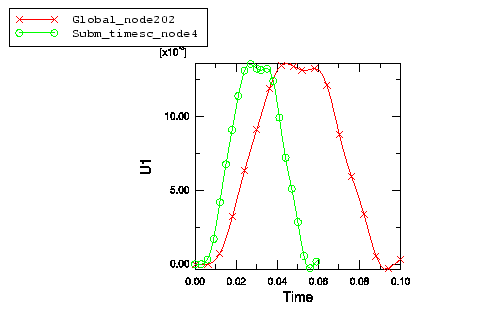Using different procedures between the global model and the submodel
Elements tested
- CAX4R
- CPS3
- CPS4R
- C3D8R
- C3D8RT
Features tested
The submodeling capability is applied to different procedures between the global model and the submodel. The global procedure can be performed in Abaqus/Explicit and the submodel procedure in Abaqus/Standard or vice versa. When appropriate, a submodel boundary condition is used to adjust the time variable of the driven nodes to match the submodel analysis step time.
Problem description
The first set of problems is based on the models that are described in Two-dimensional continuum stress/displacement submodeling. In the examples used here, however, each analysis has a second compression step. The global analysis is performed in Abaqus/Explicit, and the submodel analysis is performed in Abaqus/Standard. The step times of the analyses are different. Since the Abaqus/Explicit job is quasi-static and the Abaqus/Standard job is static, the step time from the global model is scaled to match the step time period of the submodel analysis.
The second set of tests is based on the models that are described in Coupled temperature-displacement submodeling. The global model uses C3D8R elements, and the problem is a stress/displacement analysis. The submodel uses C3D8RT elements, and it is a coupled temperature-displacement analysis. The validity of this submodeling analysis is based on the fact that the temperature effects are relatively small at the submodel level.
The last set of problems tests the direct-integration implicit dynamic procedure with submodeling. The global analysis is performed in Abaqus/Standard, and the corresponding submodeling analysis is performed in Abaqus/Explicit, or vice-versa.
Results and discussion
All of the driven variables are interpolated correctly from the global analysis. Figure 1 shows the effect of the TIMESCALE parameter on the amplitude formed at the driven nodes. If the analyses have the same step time, the two curves will be identical.
In the second and third set of tests the results agree well between the global model and the submodel.
Input files
- submproc_g_quasi2static_xpl.inp
-
Global, TIMESCALE parameter; Abaqus/Explicit quasi-static analysis.
- submproc_s_quasi2static_std.inp
-
Submodel, TIMESCALE parameter; Abaqus/Standard static analysis.
- submproc_s_quasi2static_std_sb.inp
-
Submodel, TYPE=SURFACE parameter; Abaqus/Standard static analysis.
- submproc_s_quasi2st_2nd_std.inp
-
Submodel, TIMESCALE parameter; second-order elements; Abaqus/Standard static analysis.
- submproc_g_dyn2tempdisp_xpl.inp
-
Global stress/displacement analysis; Abaqus/Explicit analysis.
- submproc_s_dyn2tempdisp_xpl.inp
-
Submodel coupled temperature-displacement driven by the stress/displacement model; Abaqus/Explicit analysis.
- submproc_s_dyn2tempdisp_std.inp
-
Submodel coupled temperature-displacement driven by the stress/displacement model; Abaqus/Standard analysis.
- submodelaxielem_cax4r_gd_xpl.inp
-
Global DYNAMIC analysis; Abaqus/Explicit analysis.
- submodelaxielem_cax4r_sd_std.inp
-
Submodel DYNAMIC analysis; Abaqus/Standard analysis.
- submodel2delem_cps4r_gd_std.inp
-
Global DYNAMIC analysis; Abaqus/Standard analysis.
- submodel2delem_cps4r_sd_xpl.inp
-
Submodel DYNAMIC analysis; Abaqus/Explicit analysis.
Figures
